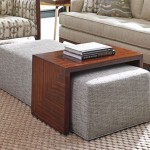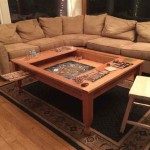How To Find The Center Of A Circular Table
Determining the center of a circular table is a task that arises in various situations, from precisely aligning a decorative element to accurately drilling a central hole for mounting purposes. While the availability of specialized tools like center finders or compasses can simplify the process, it is often necessary to rely on simple geometric principles and readily available materials to achieve the desired accuracy. This article will explore several methods for locating the center of a circular table, catering to different levels of precision and resource availability.
The accuracy required for finding the center will depend on the intended use. For example, casually centering a tablecloth might tolerate minor deviations. However, if the goal involves creating a pivot point for a rotating tabletop or installing a centered inlay, a higher degree of precision is crucial. It's also important to consider the material of the table itself. Softwood tables will be more prone to damage when marking or measuring, requiring gentler techniques compared to tables made from harder materials like metal or dense hardwood.
Before commencing any method, it is advisable to thoroughly clean the surface of the table. Dust, debris, or even slight variations in the existing finish can introduce errors in measurement. A clean surface ensures that any markings made will be readily visible and that measuring tools can make consistent contact with the table's surface.
Method 1: Using a Carpenter's Square and Straightedge
This method utilizes the principle that any inscribed angle subtending a diameter in a circle is a right angle. By creating two such right triangles within the circle, the intersection of their hypotenuses can be used to pinpoint the center. This method is easily executed with a carpenter's square, a straightedge (such as a ruler or yardstick), and a pencil.
The initial step involves placing the carpenter’s square against the edge of the circular table. Align one arm of the square flush with the table's circumference. With a pencil, carefully draw a line along the other arm of the square where it intersects the table’s surface. This line represents one leg of the inscribed right triangle.
Repeat this process, positioning the carpenter’s square at a different location along the table's edge. Ensure that the second placement is significantly different from the first – ideally, the two lines should be roughly perpendicular to each other if visualized as diameters. Again, draw a line along the arm of the square as it intersects the table surface. This line represents the second leg of the second right triangle.
Now, using the straightedge, connect the endpoints of the first line. This line represents the hypotenuse of the first inscribed right triangle. Similarly, connect the endpoints of the second line, forming the hypotenuse of the second inscribed right triangle.
The point where these two hypotenuses intersect marks the center of the circular table. It is important to note that the accuracy of this method relies on the precision with which the right angles are formed and the straight lines are drawn. A slight deviation in either can lead to errors in the final center point.
For improved precision, consider using a sharp, fine-tipped pencil to draw the lines. A dull or thick pencil can introduce ambiguity in the endpoints, affecting the accuracy of the hypotenuse placement. Additionally, use a high-quality carpenter’s square known for its accurate 90-degree angles. A warped or inaccurate square will compromise the entire process.
Method 2: Utilizing Compass and Straightedge (Geometric Construction)
This method leverages fundamental geometric principles to locate the circle's center with high accuracy. It relies on constructing perpendicular bisectors of chords within the circle. The intersection of these bisectors will precisely identify the center. This method requires a compass, a straightedge, and a pencil.
Begin by drawing a chord on the circular table. A chord is a straight line segment that connects two points on the circumference of the circle. The length and placement of the chord are not critical at this stage.
Next, construct the perpendicular bisector of the chord. To do this, set the compass to a radius that is greater than half the length of the chord. Place the compass point on one endpoint of the chord and draw an arc that extends both above and below the chord. Repeat this process with the compass point on the other endpoint of the chord, ensuring that the arc intersects the first arc in two distinct points.
Using the straightedge, connect the two points where the arcs intersect. This line is the perpendicular bisector of the chord. It is crucial that the arcs intersect cleanly and distinctly. If the arcs are too shallow or too close together, the intersection points will be less defined, reducing the accuracy of the bisector.
Repeat this process with a second chord. The second chord should not be parallel to the first chord. Ideally, the two chords should be placed at a significant angle to each other for optimal accuracy. Construct the perpendicular bisector of the second chord using the same method as before.
The point where the two perpendicular bisectors intersect is the center of the circular table. This method is inherently more accurate than the carpenter's square method, as it relies on the precise geometric construction of bisectors rather than relying on the accuracy of a right angle.
For optimal precision, it is important to use a compass with a tight hinge to prevent the radius from changing during the arc-drawing process. A wobbly compass will introduce variations in the arc radius, compromising the accuracy of the bisector. Also, ensure that the pencil lead is sharp and fine to minimize the width of the drawn lines. Thicker lines can make it difficult to precisely determine the intersection points.
Method 3: Approximating with Measurements and Visual Estimation
This method is less precise than the previous two but is suitable for situations where high accuracy is not required, or when tools are limited. It involves taking diameter measurements and visually estimating the midpoint.
Begin by measuring the diameter of the circular table. This can be done by placing a straightedge across the table, ensuring it passes through what appears to be the center. Record the measurement. It's often helpful to take several diameter measurements at different angles to ensure the table is truly circular and to identify any inconsistencies.
Divide the diameter measurement by two to determine the radius. The radius represents the distance from the center to any point on the circumference.
Now, attempt to visually estimate the center of the table. This can be done by mentally dividing the table into quadrants and identifying the point that appears equidistant from all edges. Place a light mark at this estimated center point.
Using the radius measurement, place the straightedge with one end at the estimated center point and align it towards the edge of the table. If the distance to the edge closely matches the calculated radius, it suggests the estimated center is reasonably accurate. If there's a significant discrepancy, adjust the estimated center point and repeat the measurement until a satisfactory match is achieved.
This method relies heavily on visual estimation and is therefore less precise. The accuracy can be improved by taking multiple radius measurements from different points around the estimated center and averaging the discrepancies to refine the center point's location. However, even with these refinements, this method should be reserved for applications where a small margin of error is acceptable.
This method is particularly sensitive to irregularities in the table's shape. If the table is not perfectly circular – for example, if it is slightly oval or has flat spots – the visual estimation method can be particularly unreliable. In such cases, it is advisable to revert to either the carpenter's square or compass and straightedge methods, which are less susceptible to shape irregularities.
Regardless of the chosen method, it is advisable to test the accuracy of the determined center before proceeding with any permanent modifications to the table. This can be done by drawing a circle using the identified center as the pivot point and the calculated radius as the compass setting. If the drawn circle closely aligns with the table's edge, it indicates a high degree of accuracy. If the circle deviates significantly from the table's edge, it suggests that the center point needs further refinement.

Solved A Light Source Is Located Over The Center Of Chegg Com
Solved A Light Source Is Located Over The Center Of Chegg Com

How To Find The Center Of A Circle 4 Steps Instructables

Solved 26 A Light Source Is Located Over The Center Of Chegg Com

Solved 0 1 Points Larcalc11 37 040 Center Of A Circular Chegg Com
Solved A Light Source Is Located Over The Center Of Chegg Com

How To Find The Center Of A Circle 3 Easy And Quick Ways

How To Find The Center Of A Circle 4 Steps Instructables

How To Find The Center Of A Circle 4 Steps Instructables

Mechanical Engineering Centroids Center Of Gravity 5 35 A 1 4 Circle
Related Posts








